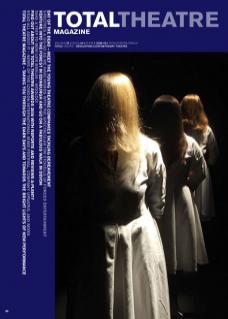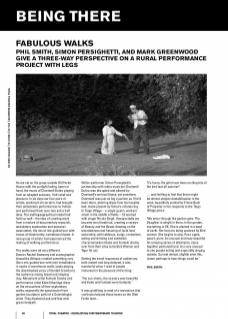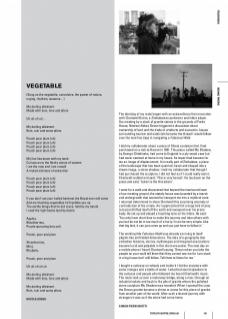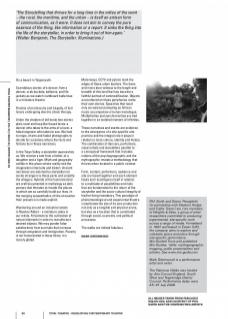As we sat on the grass outside Old Forde House with the sunlight fading, beers in hand, the music of Chartwell Dutiro playing from an adapted suitcase, I felt relief and pleasure. In six days our four pairs of artists, working from scratch, had brought their ambulatory performances to fruition and performed them over two and a half days. The mythogeographical model had held up well – the idea of creating work from a mixture of documentary research, ambulatory exploration and personal association; the mix of mis-guided tour with traces of theatricality, sometimes blazed. A new group of artists had experienced the making of walking-performance.
The walks were all very different. Dancer Rachel Sweeney and scenographer Anoushka Athique created something very like a mis-guided tour with mini-installations in nooks in warehouse walls, ipods playing the disembodied voice of Donald Crowhurst, the audience mixing bread and shaping clay. Movement artist Fumiaki Tanaka and performance artist Katie Etheridge drew on the encounters of their exploratory walks, especially the spectacular front garden (sculpture park) of a Scientologist artist. They displaced pub and fete onto green footpath.
Writer-performer Simon Persighetti’s partnership with mbira musician Chartwell Dutiro was disrupted and altered by Chartwell’s serious illness, yet somehow Chartwell was just as big a partner as if he’d been there, phoning ideas from his hospital bed, made present by Simon’s referencing. In Teign Village – a single quarry workers’ street in the middle of fields – I’d worked with singer Nicola Singh. Unexpectedly we became very theatrical, creating a version of Beauty and the Beast, drawing on the boundedness and fissuring of local land ownership, with tableaux, songs, recitations, eating and drinking and symbolist characterisation (Katie and Fumiaki driving over from their sites to be Bird Woman and Tiger for us).
Getting the email responses of audiences, both instant and long delayed, it was wonderful when I read of people immersed in the pleasure of the thing:
‘The sun shone, the scenery was beautiful and Katie and Fumiaki were fantastic.’
It was gratifying to read of a resonance that continues beyond those beers on the Olde Forde lawn…
‘It’s funny, the girls have been reciting bits of the bird text all summer!’
… and thrilling to feel that there might be almost utopian destabilisation in the work, beautifully evoked by Emma Bush of Propeller in her response to the Teign Village piece:
‘We enter through the garden gate. The Daughter is alright in there, in the garden, everything is OK. She is planted in a bowl of earth. Her feet are being watered by Bird woman. She begins to sing. Pear, apple, peach, plum. An unusual and hazy beautiful. An amazing series of allotments, close together portioned land. It is very unusual to see people acting and especially singing outside. Surreal almost, slightly siren like, closer perhaps to how things could be.’
Phil Smith
Vegetable
(Sung as the vegetable, convulsive, the power of nature, urging, rhythms, seasons…)
My darling allotment
Made with love, love and pliers
Uh uh uh uh…
My darling allotment
Ruin, ruin and some pliers
Peach pear plum (uh)
Peach pear plum (uh)
Peach pear plum (uh)
Peach pear plum (uh)
My lion lies down with my lamb
Curious as to the fleshy nature of women
I am the rose and I am unwell
A muted sickness of extraction
Peach pear plum (uh)
Peach pear plum (uh)
Peach pear plum (uh)
Peach pear plum (uh)
If you don’t eat your boiled beetroot the Beast man will come
And my blushing vegetables he’ll gobble you up
The earthy things that he did crave, held by my hands
I read the right books lead by desire
Apples,
Blackberries,
Purple sprouting broccoli,
Peach, pear and plum
Strawberries,
Mint,
Rhubarb,
Peach, pear and plum
Uh uh uh uh uh
My darling allotment
Made with love, love and pliers
My darling allotment
Ruin, ruin and some pliers
The devising of my route began with an extraordinary first encounter with Chartwell Dutiro, a Zimbabwean performer and mbira player. Our meeting by a stack of granite stones in the grounds of Forde House, Newton Abbot, Devon triggered a discussion about ownership of land and the trade of artefacts and souvenirs. Issues surrounding tourism and exoticism became the thread I would follow over the next five days in navigating a Fabulous Walk.
I told my collaborator about a piece of Shona sculpture that I had purchased on a visit to Harare in 1991. This piece called My Shadow, by George Chitalineke, had come to England in a ply-wood case but had never seemed at home in my house. Its import had become for me an image of displacement. It is really part of Zimbabwe, a piece of the landscape that has been quarried, hewn and shaped into a dream image, a stone shadow. I told my collaborator that though I had purchased the sculpture, I did not feel as if I could really own it. Chartwell nodded and said, ‘This is very honest’. He lay down on the grass and said, ‘Listen to the Ancestors’.
I went for a walk and discovered that beyond the manicured lawn of our meeting ground, the stately house was bounded by a marsh and undergrowth that seemed to transport me into a mythical zone. I returned determined to show Chartwell this surprising anomaly or contradiction of the ornate. As I approached him a large bird of prey (a buzzard) lifted itself off the earth and swooped over his prone body. He sat up and played a haunting tune on his mbira. He said: ‘You only have short time to make this journey and take others with you but do not be in too much of a hurry. It can be very simple. Like that big bird, it can just come up and you just have to follow it.’
The working title Fabulous Walk was already accruing to itself pilgrim-like and fabled dimensions. The idea of a geography that embodies histories, stories, mythologies and imagined associations became lucid and palpable in this short encounter. The next day on a mobile phone I heard Chartwell saying: ‘Simon when you take the people on your walk tell them that they cannot see me for I am stuck in a big house but I will follow. Tell them to listen for me.’
I bought a suitcase on wheels and inside it I hid the sculpture with some oranges and a bottle of water. I attached sound speakers to the suitcase and people who followed me heard Chartwell’s music. The route took us over a motorway bridge, along a river, through an industrial estate and back to the pile of granite where the polished stone sculpture My Shadow was revealed. When I opened the case the Devon granite became a shrine or arena for this piece of granite from another part of the world. After such a shared journey with strangers it was as if the stone had come home.
Simon Persighetti
On a beach in Teignmouth.
Scandalous stories of a dancer from a dancer, crab buckets, balloons, and life jackets as we watch cardboard ballerinas in a miniature theatre.
Dramas of promiscuity and tragedy, of lost lovers undergoing electric shock therapy.
Under the shadow of old boots two stories plait, ravel and loop like frayed laces: a dancer who takes to the arms of a lover, a failed engineer who takes to sea. We look to maps, charts and faded photographs to decide for ourselves where the facts and fictions lie in these narratives.
In the Teign Valley a storyteller approaches us. We receive a tale from a father, of a daughter and a tiger. Myth and geography collide in this place where reality and the imagination intercede and distort. Ancient narratives are adorned by storytellers to excite strangers to these parts and unsettle the villagers. Hybrids of the human/animal are well documented in mythology as dark powers that threaten to invade the places in which we so carefully build our lives. In the merging synaesthetics of this encounter their presence is made explicit.
Wandering around an industrial estate in Newton Abbot – a miniature zebra in our minds. A footnote to the cultivation of natural elements in order to manufacture desired objects. We may ponder false satisfactions from survivals that increase through emigration and immigration. Poverty is not transcended in these flows: it is merely gilded.
Motorways, CCTV and pylons mark the edges of these urban borders. The trees and rivers bear witness to the length and breadth of this land that has become a faithful portrait of commodification. Objects encountered on these peripheries recite their own stories. Speeches that need only occasional prompting as African music accompanies a human monologue. Multiplicities and synchronicities are tied together in an isolated moment of infinities.
These narratives and events are evidence to the emergence of a site-specific arts practice and the integral role it plays in relation to local culture, identity and history. The combination of dancers, performers, visual artists and storytellers parallel to a conceptual framework that includes notions of the psychogeographic and the mythographic reveals a methodology that thrives when located in a public context.
Form, content, performers, audience and site are fused together and each element feeds and reconfigures itself in relation to a multitude of possibilities and risks that are fundamental to the return of the storyteller and the socio-cultural integrity of his/her living immediacy. This paradigm of phenomenological and experiential theatre complicates the site of its own production not only as a tangible and physical arena, but also as a location that is constituted through social, economic and political processes.
The walks are indeed fabulous.
Mark Greenwood
Phil Smith and Simon Persighetti (in partnership with Stephen Hodge and Cathy Turner) are core members of Wrights & Sites, a group of artistresearchers committed to producing experimental, site-specific work across a range of media. Formalised in 1997 and based in Exeter (UK), the company aims to explore and celebrate space and place through site-specific performance, Mis-Guided Tours and published Mis-Guides, ‘drifts’, mythogeographic mapping, public presentations and articles. See www.mis-guide.com
Mark Greenwood is a performance artist and writer.
The Fabulous Walks was funded by Arts Council England, South West and Teignbridge District Council. Performance dates were 25–27 July 2008.



